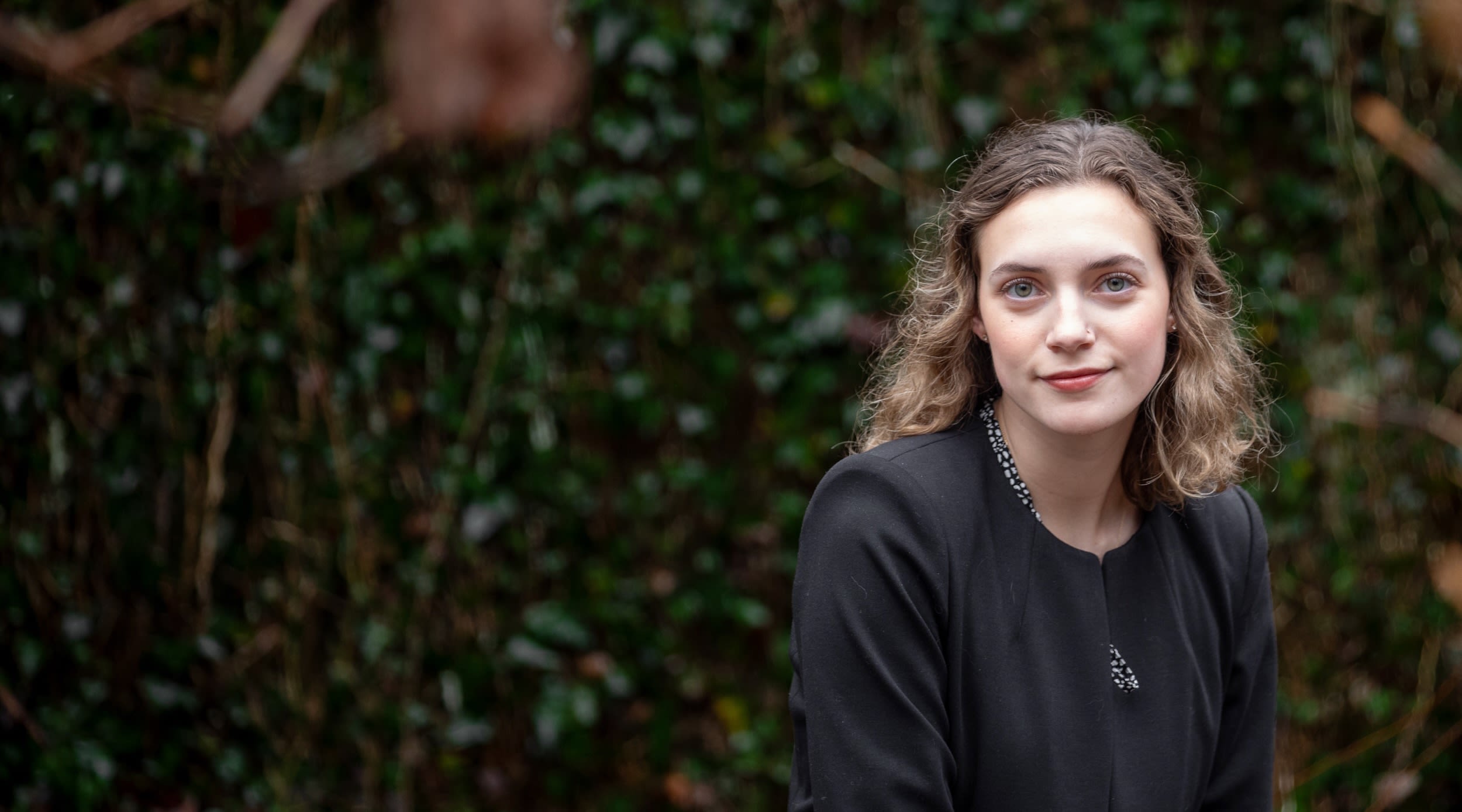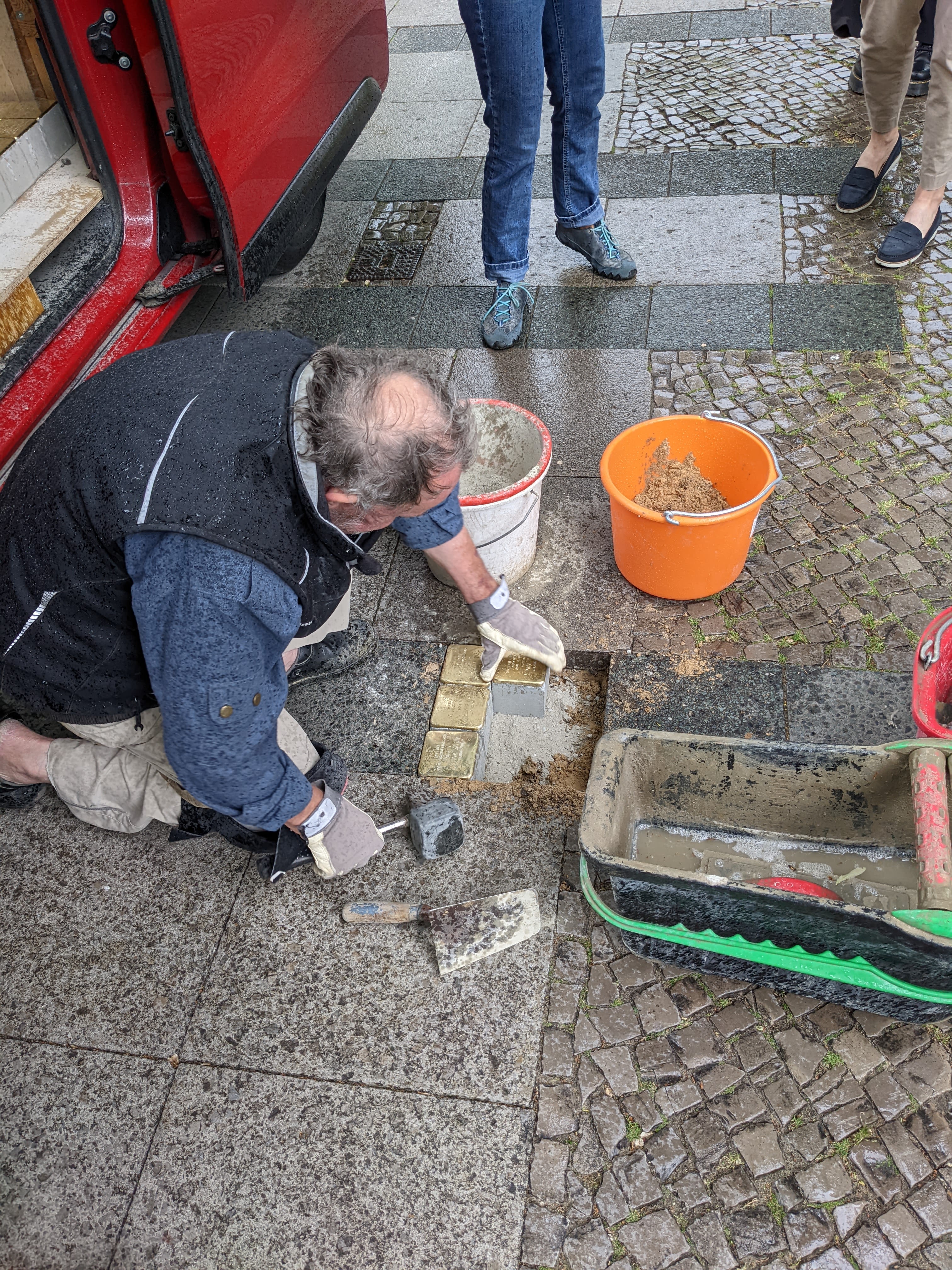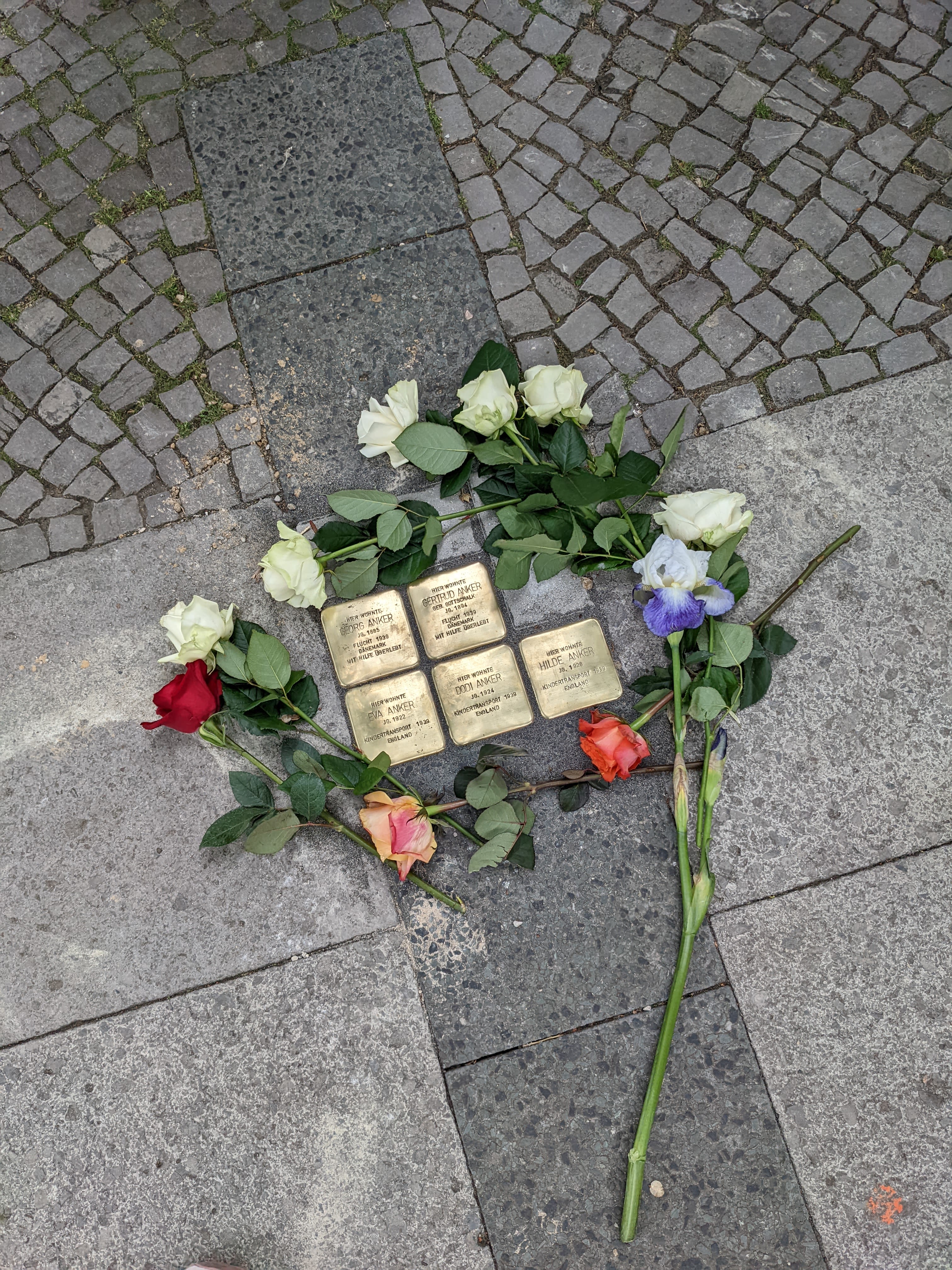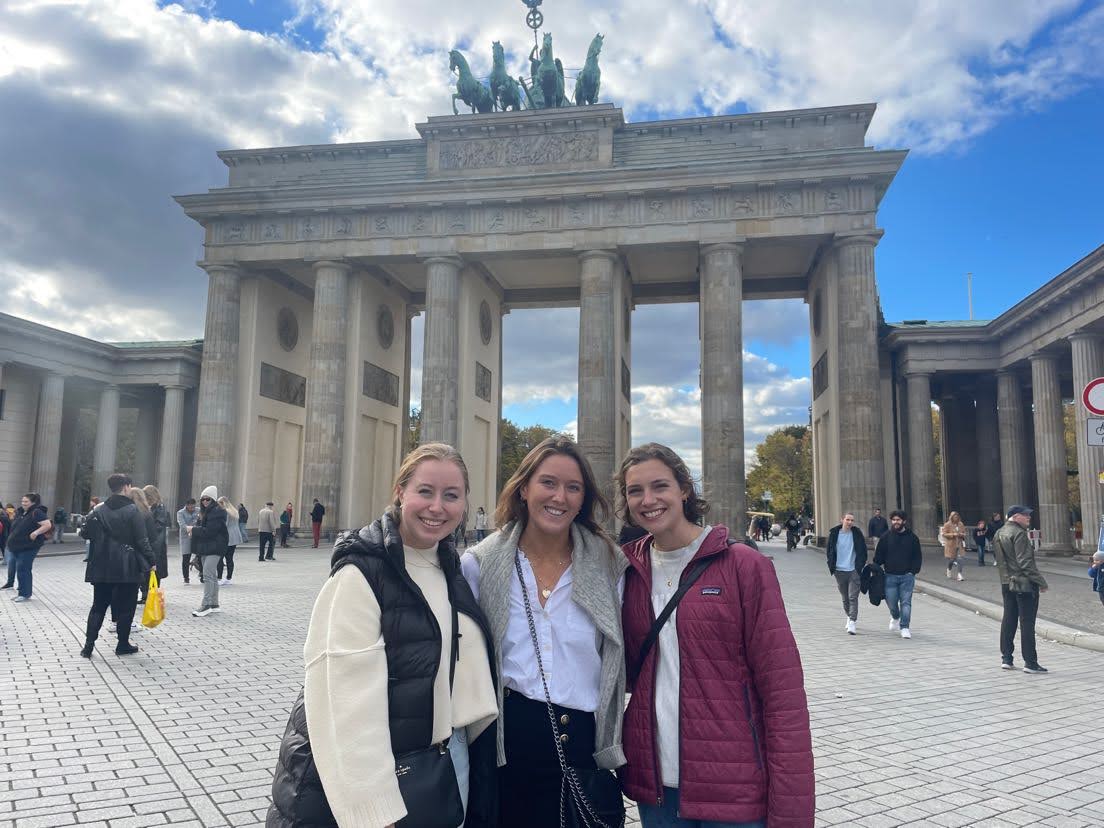Bearing Witness
A two-year odyssey takes a Sewanee history and German major from Tennessee to Berlin to navigate a web of archives and emotional revelations as she uncovers the lost stories of Holocaust victims.

If you were to walk down a residential street in Berlin, you might notice that, every so often, the metallic glimmer of brass jumps out from among the cobblestones underfoot. A closer inspection would reveal a 10-centimeter by 10-centimeter plaque laid flush with the existing sidewalk, its face bearing a single name and a sparse collection of biographical information. First name, last name, and birth date are all included, as one might expect. But so are a few more chilling details: date of arrest, when and where the person was deported to a concentration camp, and the date of their murder.
Part of a decades-long art installation and memory project, each plaque—or Stolperstein (“stumbling stone”)—commemorates the last voluntary address of an individual victim of the Holocaust. Each stone shares one person’s fate, with the project as a whole encompassing the stories of those who were deported, those who were killed, and those who managed to flee. More than 100,000 of the Stolpersteine have thus far been placed in big cities and small towns all over Europe, each one pursued at the request of an individual’s descendants and exhaustively researched to capture and honor lives both lost and interrupted.
Among the many volunteer researchers who have helped to turn such requests into stones is Rebecca Cole, C’24, a senior history and German and German studies major. And what began for her as a summer research fellowship would wind up becoming a two-year journey that encapsulated two study abroad programs, two senior theses, and a perspective-shifting firsthand experience with the reverberations of the past into the present.
Cole did not arrive at Sewanee intending to be a history major, and she had not planned on studying German. But she fell in love with history after taking her first courses in the discipline and, after having been placed into German during her first semester, discovered an affinity for the cultural and historical perspectives that faculty in the German Department incorporated into her language learning. Certain that she wanted to study abroad in her junior year, it made sense that Berlin would then emerge as an attractive destination—so much so, it turned out, that Cole enrolled in both the Sewanee summer and semester in Berlin programs.
With the programs set to occur back-to-back with a couple months’ gap between them, Cole began looking for an internship or research opportunity to bridge the two experiences. She contacted then Associate Professor of International and Global Studies Shana Minkin, who was living in Berlin at the time and a volunteer with the Stolpersteine project. They alighted on a research question investigating Holocaust commemoration, and Cole secured funding for the project with both an Appalachian College Association Ledford Scholarship award and a Summer Undergraduate Research Fellowship. Cole’s connection to the Stolpersteine project also netted her a place to live for the summer—with the leader of the specific project group with which she would be working.
“Since it's a very localized and decentralized project, it is broken up by neighborhoods,” says Cole. For each neighborhood, a small group would research the individuals who had lived there and whose Stolperstein would eventually be placed there. Cole worked with the team assigned to the Mitte district of Berlin, one of the city’s central boroughs and home to such landmarks as the Brandenburg Gate and the Tiergarten park.
Each individual Stolperstein begins with a request from the victim’s family, who provide as much information about their relative’s whereabouts and fate as they can. Because of the overwhelming number of requests received, it can be months or years before the research begins. Once it does, volunteer researchers like Cole set out to collect and distill as much information about the person as possible to generate a biography to accompany the stone.
“We would look for anything we could find on them and their lives and what happened to them, but also their family members,” says Cole. “Because a lot of families were displaced and went in all different directions, people are looking to reunite their family through this process.”
For Cole, that meant hours spent poring over archival material both online via digital archives and in person at various sites throughout Berlin. Because many of the documents she encountered were handwritten rather than typewritten, it also meant that she had to familiarize herself with old German handwriting, a cursive form of the language that bears little resemblance to how it’s written today.
As she dug deep into the lives of people she was never able to meet, Cole found herself developing a marked sense of closeness to her research subjects. “It was very, very personal research,” she says. “You learn where they were born, who their families were, what they did for their jobs, where they lived, and even everything they owned because of the records kept by the German government after they removed people from their homes.”
Occasionally, Cole and her fellow researchers would uncover something unexpected, often with the power to completely alter a family’s understanding of their history. In one stunning instance, the team found that the individual they were researching had not, as was long presumed, been murdered at a concentration camp but had survived and eventually emigrated to New York.
Though such revelations can be challenging, Cole ultimately believes in their value to those seeking to remember their lost ancestors. “There are so many rewarding things about being able to learn what actually happened,” says Cole. “Even if it changes your narrative, you now have a better understanding.”


As summer came to a close and Cole moved to join her Sewanee peers for the Advent semester program, her involvement with the Stolpersteine project didn’t end. Having grown attached to the people she was researching, Cole continued her research activities in order to carry her last cases to the finish line.
And after having had an on-the-ground introduction to how the Holocaust is remembered at the individual level, she then started to look at the topic more broadly. She found time to visit memorials and monuments not just in Berlin, but all over Europe, with her travels also taking her to Prague and Warsaw.
In making sense of her collected experiences, Cole knitted them together and found her way to what would become her senior thesis, in which she examined the evolution of East German Holocaust remembrance from the end of World War II until the fall of the Berlin wall in 1989. In particular, she looked at the role that the memory of the Holocaust played in national identity formation, eventually finding that the dominant scholarly narrative—one of a monolithically silenced Jewish victimhood—was in actuality significantly more nuanced.
Next, she’ll take that project one step further as she writes an honors thesis in her last semester, this time looking at Holocaust memory in West Germany over the same time frame. While her specific post-graduation plans are not yet set, she’s certain that she’ll continue to go deeper on this research topic as a graduate student in history, Jewish studies, or a similar field.
Even after having spent the better part of two years buried in books, historical records, and other documents, Cole is still reckoning with what it means to continually confront one of humanity’s darkest chapters through an academic lens. The nature of the Stolpersteine project research in particular, with its individual focus and immediate connection to victims’ families, bore a distinct sense of heaviness.
“You’re looking at the bureaucratic view of this person’s life, and it seems like that might make you feel removed from them,” says Cole. “But I think it had almost the opposite effect. I knew this person’s entire life, and developed a very personal connection to someone who had passed away decades ago. It was very emotional for me.”

Rebecca Cole (right) and Sewanee classmates at the Brandenburg Gate during their semester in Germany. In the Solpersteine project, Cole was assigned to Berlin's Mitte district, home to the 18th-century monument.
Rebecca Cole (right) and Sewanee classmates at the Brandenburg Gate during their semester in Germany. In the Solpersteine project, Cole was assigned to Berlin's Mitte district, home to the 18th-century monument.
Yet Cole has never wavered on the value of the endeavor. Projects like the Stolpersteine, in her view, are ultimately more fulfilling than they are challenging. “It was very difficult, but also very rewarding because you feel like you’re doing positive work,” says Cole. “You’re doing work that helps to comfort the family and do this person justice by figuring out what happened to them.”
Though her current research has taken her away from such intensely personal narratives, Cole remains ever cognizant of the weight and import of her study. With the number of years separating us from the Holocaust growing and the number of surviving first-person witnesses to its atrocities dwindling, she sees the act of remembering—and examining how we communally remember—as critical to understanding and interpreting contemporary world events.
“This history is very relevant to what’s happening in the world today,” says Cole. “As we look at the rise of far-right extremism and the conflicts happening in Ukraine and the Middle East, I think that looking back at historical acts of genocide and violence are important to understanding how to move on in the world today.”
